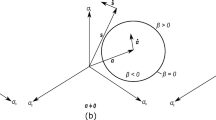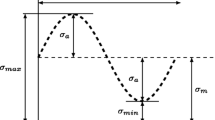Abstract
This work investigates efficient topology optimization for finite-life high-cycle fatigue damage using a density approach and analytical gradients. To restrict the minimum mass problem to withstand a prescribed finite accumulated damage, constraints are formulated using Palmgren-Miner’s linear damage hypothesis, S-N curves, and the Sines fatigue criterion. Utilizing aggregation functions and the accumulative nature of Palmgren-Miner’s rule, an adjoint formulation is applied where the amount of adjoint problems that must be solved is independent of the amount of cycles in the load spectrum. Consequently, large load histories can be included directly in the optimization with minimal additional computational costs. The method is currently limited to proportional loading conditions and linear elastic material behavior and a quasi-static structural analysis, but can be applied to various equivalent stress-based fatigue criteria. Optimized designs are presented for benchmark examples and compared to stress optimized designs for static loads.






Similar content being viewed by others
References
Akgün MA, Haftka RT, Wu KC, Walsh JL, Garcelon JH (2001) Efficient structural optimization for multiple load cases using adjoint sensitivities. AIAA J 39:511–516
Andreassen E, Clausen A, Schevenels M, Lazarov BS, Sigmund O (2011) Efficient topology optimization in MATLAB using 88 lines of code. Struct Multidiscip Optim 43:1–16
Bendsøe MP (1989) Optimal shape design as a material distribution problem. Struct Optim 1:193–202
Bendsøe MP, Kikuchi N (1988) Generating optimal topologies in structural design using a homogenization method. Comput Methods Appl Mech Eng 71:197–224
Bendsøe MP, Sigmund O (1999) Material interpolation schemes in topology optimization. Arch Appl Mech 69:635–654
Bendsøe MP, Sigmund O (2004) Topology optimization - theory, methods, and applications, 2nd edn. Springer-Verlag, Berlin Heidelberg
Bourdin B (2001) Filters in topology optimization. Int J Numer Methods Eng 50:2143–2158
Bruggi M (2008) On an alternative approach to stress constraints relaxation in topology optimization. Struct Multidiscip Optim 36:125–141
Bruggi M, Duysinx P (2012) Topology optimization for minimum weight with compliance and stress constraints. Struct Multidiscip Optim 46:369–384
Bruns TE, Tortorelli DA (2001) Topology optimization of non-linear elastic structures and compliant mechanisms. Comput Methods Appl Mech Eng 190:3443–3459
Cheng GD, Guo X (1997) ε-relaxed approach in structural topology optimization. Struct Optim 13:258–266
Collet M, Bruggi M, Duysinx P (2017) Topology optimization for minimum weight with compliance and simplified nominal stress constraints for fatigue resistance. Struct Multidiscip Optim 55:839–855
Díaz A, Sigmund O (1995) Checkerboard patterns in layout optimization. Struct Optim 10:40–45
Dorn WS, Gomory RE, Greenberg HJ (1964) Automatic design of optimal structures. J Mech 3:25–52
Duysinx P, Bendsøe MP (1998) Topology optimization of continuum structures with local stress constraints. Int J Numer Methods Eng 43:1453–1478
Duysinx P, Sigmund O (1998) New developments in handling stress constraints in optimal material distribution. In: 7th AIAA/USAF/NASA/ISSMO Symposium on Multidisciplinary Analysis and Optimization. American Institute of Aeronautics and Astronautics
Grunwald J, Schnack E (1998) Modeling fatigue for shape optimization of dynamically loaded parts. Adv Eng Softw 29:63–67
Holmberg E (2013) Stress and fatigue constrained topology optimization. Licentiate Thesis No. 1571, Linköping University, Sweden
Holmberg E, Torstenfelt B, Klarbring A (2013) Stress constrained topology optimization. Struct Multidiscip Optim 48:33–47
Holmberg E, Torstenfelt B, Klarbring A (2014) Fatigue constrained topology optimization. Struct Multidiscip Optim 50:207–219
Jeong SH, Choi D-H, Yoon GH (2015) Fatigue and static failure considerations using a topology optimization method. Appl Math Model 39:1137–1162
Jog CS, Haber RB (1996) Stability of finite element models for distributed-parameter optimization and topology design. Comput Methods Appl Mech Eng 130:203–226
Kaya N, Karen İ, Öztürk F (2010) Re-design of a failed clutch fork using topology and shape optimisation by the response surface method. Mater Des 31:3008–3014
Kim Y-I, Park G-J (2010) Nonlinear dynamic response structural optimization using equivalent static loads. Comput Methods Appl Mech Eng 199:660–676
Kirsch U (1990) On singular topologies in optimum structural design. Struct Optim 2:133–142
Kreisselmeier G, Steinhauser R (1980) Systematic Control Design By Optimizing a Vector Performance Index. In: M.A. Cuenod, P (ed) Computer Aided Design of Control Systems. pp 113–117 doi:10.1016/B978-0-08-024488-4.50022-X
Le C, Norato J, Bruns T, Ha C, Tortorelli D (2010) Stress-based topology optimization for continua. Struct Multidiscip Optim 41:605–620
Luo Y, Kang Z (2012) Topology optimization of continuum structures with Drucker–Prager yield stress constraints. Comput Struct 90:65–75
Luo Y, Wang MY, Kang Z (2013) An enhanced aggregation method for topology optimization with local stress constraints. Comput Methods Appl Mech Eng 254:31–41
Mrzyglod M, Zielinski AP (2006) Numerial implementation of multiaxial high-cycle fatigue criterion to structural optimization. J Theor Appl Mech 44:691–712
Norato J, Le C, Ha C (2012) Fatigue-based topology optimization method and tool. US Patent Application No. 13/692,268
Oest J, Sørensen R, Overgaard LCT, Lund E (2017) Structural optimization with fatigue and ultimate limit constraints of jacket structures for large offshore wind turbines. Struct Multidiscip Optim 55:779–793
París J, Navarrina F, Colominas I, Casteleiro M (2009) Topology optimization of continuum structures with local and global stress constraints. Struct Multidiscip Optim 39:419–437
París J, Navarrina F, Colominas I, Casteleiro M (2010) Block aggregation of stress constraints in topology optimization of structures. Adv Eng Softw 41:433–441
Park GJ, Kang BS (2003) Validation of a structural optimization algorithm transforming dynamic loads into equivalent static loads. J Optim Theory Appl 118:191–200
Sherif K, Witteveen W, Puchner K, Irschik H (2010) Efficient topology optimization of large dynamic finite element systems using fatigue. AIAA J 48:1339–1347
Sigmund O (2001) A 99 line topology optimization code written in Matlab. Struct Multidiscip Optim 21:120–127
Sigmund O, Petersson J (1998) Numerical instabilities in topology optimization: a survey on procedures dealing with checkerboards, mesh-dependencies and local minima. Struct Optim 16:68–75
Sines G (1959) Behavior of metals under complex static and alternating stresses. Met Fatigue:145–169
Stephens RI, Fatemi A, Stephens RR, Fuchs HO (2000) Metal fatigue in engineering, 2nd edn. John Wiley & Sons, New York
Svanberg K (1987) The method of moving asymptotes—a new method for structural optimization. Int J Numer Methods Eng 24:359–373
Svanberg K (2007) MMA and GCMMA - version September 2007. Stockholm, Sweden
Sved G, Ginos Z (1968) Structural optimization under multiple loading. Int J Mech Sci 10:803–805
Verbart A, Langelaar M, van Keulen F (2017) A unified aggregation and relaxation approach for stress-constrained topology optimization. Struct Multidiscip Optim 55:663–679
Yang RJ, Chen CJ (1996) Stress-based topology optimization. Struct Optim 12:98–105
Zhou M, Rozvany GIN (1991) The COC algorithm, part II: topological, geometrical and generalized shape optimization. Comput Methods Appl Mech Eng 89:309–336
Acknowledgements
This research is part of the project ABYSS – Advancing BeYond Shallow waterS – Optimal design of offshore wind turbine support structures, sponsored by the Danish Council for Strategic Research, Grant no. 1305-00020B. This support is gratefully acknowledged.
Author information
Authors and Affiliations
Corresponding author
Appendix
Appendix
In the following the partial derivatives in the sensitivity analysis of the fatigue constraint are written using the chain rule of differentiation. The independence or linear dependence on the load scaling factors is indicated.
The partial derivative of the fatigue constraint with respect to a physical design variable \( {\tilde{x}}_j \) can be written as:
In this equation, the Sines stress differentiated with respect to the stress components and the stress components differentiated with respect to the physical design variables do not need to be calculated directly for each stress cycle i. Consequently, only the computational inexpensive partial derivatives \( \partial {D}_{j_i}/\partial {N}_{j_i} \) and \( \partial {N}_{j_i}/\partial {\tilde{\sigma}}_{j_i} \) need to be calculated for every load cycle.
The partial derivative of the aggregated constraint function with respect to the accumulated damage is given by:
The partial derivative of the damage with respect to the estimated amount of cycles to failure is:
The partial derivative of the estimated cycles to failure with respect to the Sines equivalent stress is:
The partial derivatives of the Sines equivalent stress are found by:
Note that these values are unscaled and it is therefore not necessary to calculate these derivatives for each cycle i. Similarly, the stress components differentiated with respect to the physical design variables can be calculated independently of the cycles, i.e. without the scaling factors:
Likewise, the partial derivative of the constraint function with respect to the amplitude and mean displacement, that are required to solve the adjoint problem can be found by:
Here the partial derivatives of the amplitude and mean stress components with respect to the reference displacements are constant in each iteration and calculated by:
Note that the constitutive matrix and strain-displacement matrix are constant and equal for all elements in this work.
As can be seen from the above equations, the additional computational costs as compared with stress constraints are the analysis and derivatives of Basquin’s equation and Palmgren-Miner’s equation, assuming that the computational cost of the Sines equivalent stress criterion is similar to a stress criterion. Furthermore, the equations that must be evaluated for each cycle i are either computational inexpensive or can be found by linear scaling. Consequently, the sensitivity analysis for fatigue constraints can be done very efficiently.
Rights and permissions
About this article
Cite this article
Oest, J., Lund, E. Topology optimization with finite-life fatigue constraints. Struct Multidisc Optim 56, 1045–1059 (2017). https://doi.org/10.1007/s00158-017-1701-9
Received:
Revised:
Accepted:
Published:
Issue Date:
DOI: https://doi.org/10.1007/s00158-017-1701-9




